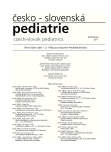Breastfeeding rates at the time of hospital discharge in Baby-Friendly and non-Baby-Friendly hospitals in the Czech Republic in 2000–2006
Authors:
A. Mydlilová 1; A. Šípek 2; J. Wiesnerová 3
Authors‘ workplace:
Národní laktační centrum, Fakultní Thomayerova nemocnice, Praha1, vedoucí MUDr. A. Mydlilová, Oddělení lékařské genetiky, Fakultní Thomayerova nemocnice, Praha2, primář MUDr. V. Gregor, Oddělení biostatistiky a informatiky, ÚZIS, Praha3, ředitel Mgr. J. H
Published in:
Čes-slov Pediat 2011; 66 (4): 207-214.
Category:
Original Papers
Overview
Purpose:
To compare the type of infant feeding at hospital discharge in Baby-Friendly (BF), non-Baby-Friendly (non-BF) hospitals, neonatal intermediate care units (NICU) and perinatal centres (PC) in the Czech Republic.
Methods:
Data from 660,355 infants born from 2000 to 2006 were collected retrospectively from newborn reports and statistically analyzed.
Results:
The exclusive breastfeeding rates decreased in BF hospitals from 92.9% in 2000 to 90.3% in 2006, whereas in non-BF hospitals from 89.4% in 2000 to 87.6% in 2006. Partial breastfeeding in BF hospitals increased from 3.6% in 2000 to 5.7% in 2006, whereas in non-BF hospitals from 4.9% in 2000 to 6.8% in 2006. Exclusive formula feeding rates changed only slightly. The risk of not being exclusively breastfed was higher in non-BF than in BF-hospitals (unadjusted OR=1.57, 95% CI 1.47–1.68 for year 2000, OR=1.6, 95% CI 1.53–1.68 for year 2004 and OR=1.36, 95% CI 1.3–1.42 for year 2006). In hospitals with PC and NICU the exclusive breastfeeding rates were lower than in hospitals without those departments.
Conclusion:
The exclusive breastfeeding rates in the Czech Republic declined from 2000 to 2006 in spite of growing number of Baby-Friendly hospitals and even in them. Nevertheless the breastfeeding rates were significantly better in Baby-Friendly hospitals. The BFHI itself is not sufficient to maintain high breastfeeding rates and it is necessary to develop other programs supporting breastfeeding.
Key words:
breastfeeding, Baby-Friendly hospitals
Sources
1. World Health Organization. Evidence for the ten steps to successful breastfeeding. Geneva: World Health Organization, 1998.
2. Braun M, Giugliani E, Soares M, et al. Evaluation of the impact of the Baby-Friendly Hospital Initiative on rates of breastfeeding. Am J Pub Med 2003; 93(8): 1277–1279.
3. Moore T, Gauld R, Williams S. Implementing Baby Friendly Hospital Initiative policy: the case of New Zealand public hospitals. Int Breastfeeding J 2007; 2: 8.
4. Pérez-Escamilla R. Evidence based Breast-feeding promotion: the Baby-Friendly Hospital Initiative. J Nutr 2007; 137: 484–487.
5. Broadfoot M, Britten J, Tappin D, et al. The Baby Friendly Hospital Initiative and breastfeeding rates in Scotland. Arch Dis Child Fetal Neonatal Ed 2005; 90: 114–116.
6. Kramer MS, Chalmers B, Hodnett ED, et al. Promotion of Breastfeeding Intervention Trial (PROBIT): A randomized trial in the Republic of Belarus. JAMA 2001; 285: 413–420.
7. Philipp BL, Malone KL, Cimo S, et al. Sustained breastfeeding rates at a US Baby-Friendly Hospital. Pediatrics 2003; 112: 234–236.
8. Weng DR, Hsu CS, Gau ML, et al. Analysis of the outcomes at baby friendly hospitals: Appraisal in Taiwan. Kaohsiung J Med Sci 2003; 19: 19–28.
9. Caldeira AP, Goncalves E. Assessment of the impact of implementing the Baby friendly hospital initiative. J Pediatr 2007; 83(2): 127–132.
10. Cattaneo A, Buzzetti R. Effect on rates of breast feeding of training for the Baby Friendly Hospital Initiative. Br Med J 2001; 323: 1358–1362.
11. Lyubov VA. The breastfeeding support and promotion in Baby- -Friendly Maternity Hospitals and not-as-yet Baby-Friendly Hospitals in Russia. Breastfeeding Medicine 2006; 1(2): 71–78.
12. Merewood A, Mehta SD, Chamberlain LB, et al. Breastfeeding rates in US Baby-Friendly hospitals: Results of a national survey. Pediatrics 2005; 116(3): 628–634.
13. Merten S, Dravta J, Ackerman-Liebrich U. Do Baby-Friendly hospitals influence breastfeeding duration on a national level? Pediatrics 2005; 116: 702–708.
14. Wright A, Rice S, Wells S. Changing hospital practices to increase the duration of breastfeeding. Pediatrics 1996; 97(5): 669–675.
15. Merewood A, Philips BL, Cimo S. The Baby-Friendly Hospital Initiative increases breastfeeding rates in a US neonatal intensive care unit. J Hum Lact 2003; 19(2): 166–171.
16. Labbok MH, Krasovec K. Towards consistency in breastfeeding definitions. Stud Fam Plan 1990; 21(4): 226–230.
17. Graham K, Scott J, Binns C, et al. National targets for breastfeeding at hospital discharge have been achieved in Perth. Acta Paediatr 2005; 94: 352–356.
18. Kovach AC. A 5-year follow-up study of hospital breastfeeding policies in the Philadelphia area: A comparison with the ten steps. J Hum Lact 2002; 18(2): 144–154.
19. Moura de Araújo MF, Soares Schmitz BA. Reassessment of Baby-friendly hospitals in Brazil. J Hum Lact 2007; 23(3): 246–252.
20. Cattaneo A, Buzzetti R. Effect on rates of breast feeding of training for the Baby Friendly Hospital Initiative. BMJ 2001; 323: 1358–1362.
21. Mydlilová A, Šípek A, Weisnerová J. Vliv některých faktorů na počet kojených dětí při propuštění z porodnice v letech 2000–2004 v ČR. Čes-slov Pediat 2008; 68(4): 182–191.
Labels
Neonatology Paediatrics General practitioner for children and adolescentsArticle was published in
Czech-Slovak Pediatrics

2011 Issue 4
Most read in this issue
- Mucopolysaccharidosis I – clinical manifestations in 24 children from the Czech Republic and Slovakia
- Paediatric enteral nutrition: practical approach based on ESPGHAN recommendations
- Arterial cerebral event in childhood
- Breastfeeding rates at the time of hospital discharge in Baby-Friendly and non-Baby-Friendly hospitals in the Czech Republic in 2000–2006
